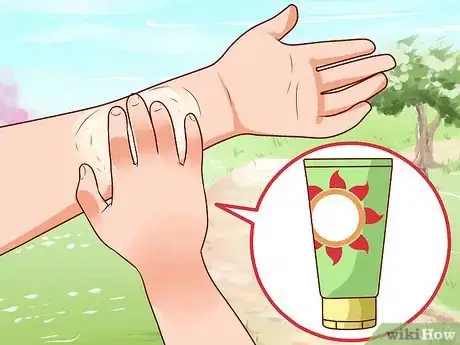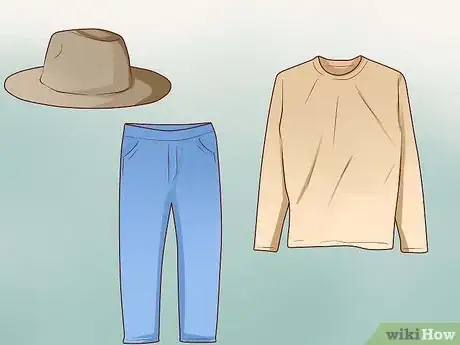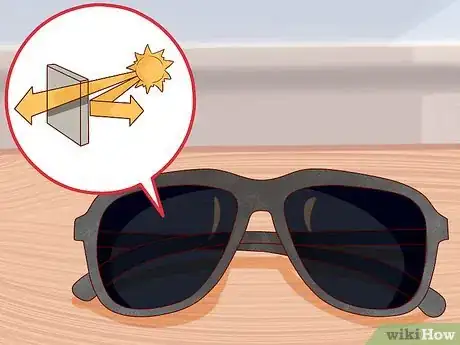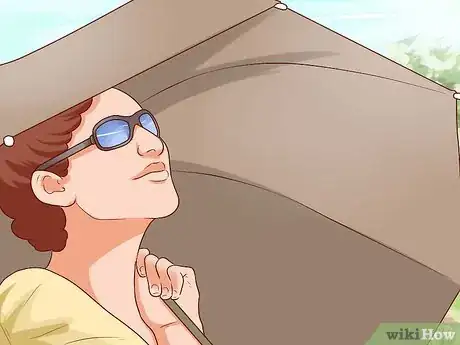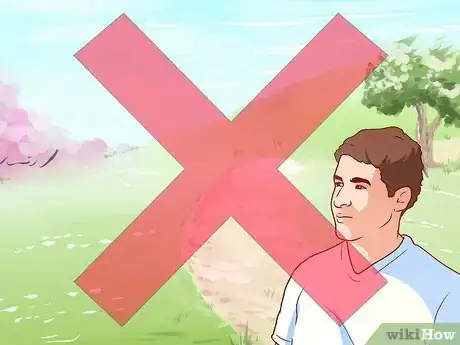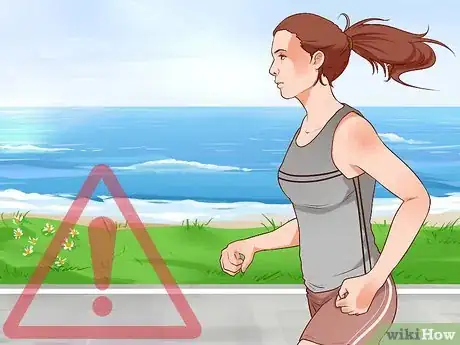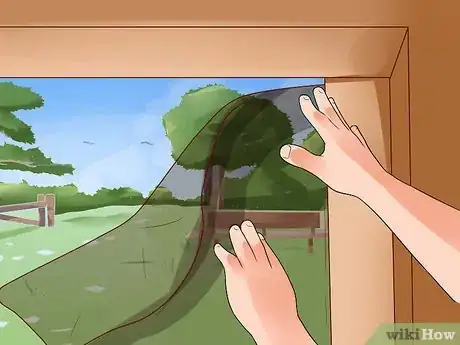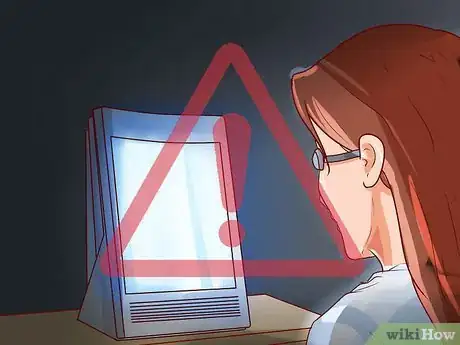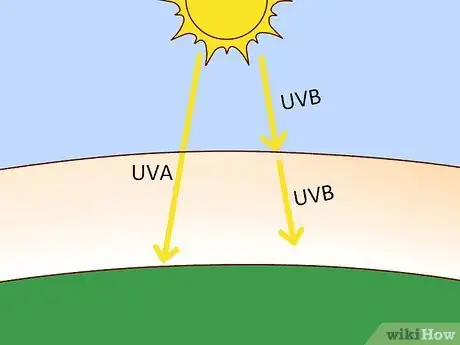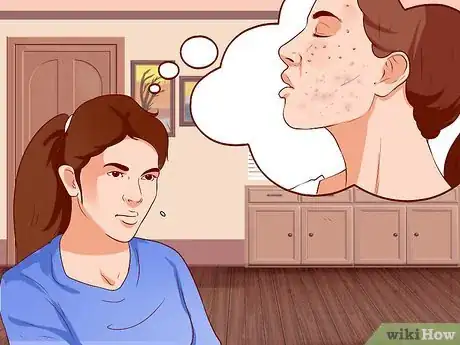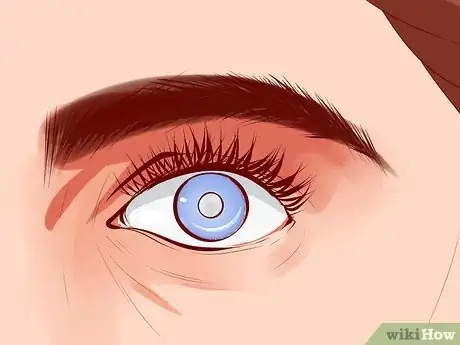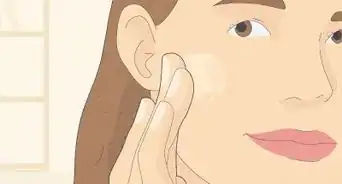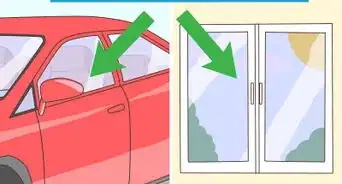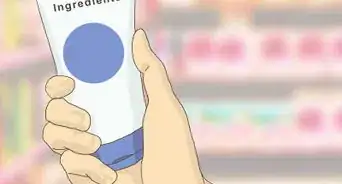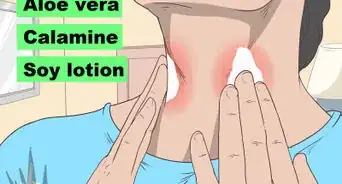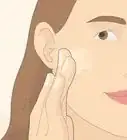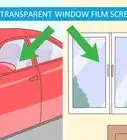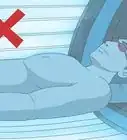This article was medically reviewed by Luba Lee, FNP-BC, MS. Luba Lee, FNP-BC is a Board-Certified Family Nurse Practitioner (FNP) and educator in Tennessee with over a decade of clinical experience. Luba has certifications in Pediatric Advanced Life Support (PALS), Emergency Medicine, Advanced Cardiac Life Support (ACLS), Team Building, and Critical Care Nursing. She received her Master of Science in Nursing (MSN) from the University of Tennessee in 2006.
This article has been viewed 41,579 times.
Ultraviolet (UV) radiation exposure is one of the leading causes of skin cancer and vision damage. The effects of UV radiation often take many years to develop, which means you may not notice the damage until it's too late. Taking precautions and reducing or avoiding UV exposure can help prevent effects like skin cancer, cataracts, premature aging. Stay safe in the sun and you will have healthy skin and eyes for many years to come.
Steps
Staying Safe in the Sun
-
1Wear broad-spectrum sunscreen. It's not enough to wear sunscreen. You need to wear the right kind of sunscreen and keep reapplying it regularly throughout the day in order to ensure that you are adequately protected in the sun. Broad-spectrum sunscreen protects against both types of radiation, meaning you'll get the best protection you can against UV exposure.[1]
- By law, broad-spectrum sunscreen must pass rigorous testing procedures to ensure that it protects against both UVA and UVB radiation.
- In addition to selecting broad-spectrum sunscreen, make sure your sunscreen has an SPF (sun protection factor) of at least 15, though you may want to go with an even higher SPF to reduce the risk of sunburn and UV exposure.
- Make sure your sunscreen is still effective by checking the expiration date printed on the bottle. Even if it's still good, you may need to vigorously shake the container to mix the ingredients back together.
- Use about one palmful of sunscreen to completely cover your face, neck, arms, and legs. Reapply at least every two hours, or more frequently if you'll be swimming or sweating.
- Waterproof sunscreen only protects you for 40 to 80 minutes of swimming or sweating. After that, you'll need to reapply more sunscreen.
-
2Put on protective clothing. Protective clothing can help shield your body from direct UV exposure. If you're planning on being outdoors for a day of hiking, a picnic, yard work, or just lounging in the sun, make sure you wear appropriately protective clothing in addition to sunscreen.[2]
- Wear a hat with a brim that extends at least two to three inches on all sides.
- Long-sleeved shirts and long pants provide the most protection.
- Some articles of clothing come with a built-in UV protection factor. Check the labels and tags on an article of clothing to determine if that item provides UV protection.
- Darker fabrics may make you feel warmer in the sun, but they are also believed to protect your skin from UV radiation better than light-colored fabric.
- Dry fabric may be more protective than wet fabric, but wet fabric is better than no clothing at all.
- Opt for tightly-woven articles of clothing, which block out more UV radiation than loosely-woven fabrics.
- As a quick test, try holding up your hand under a single layer of clothing in direct light. If your hand is visible through the fabric, it's not tightly-woven enough to provide any real protection.
Advertisement -
3Use UV-blocking, polarized sunglasses. Even when you wear broad-spectrum sunscreen, your eyes are still at risk of being damaged by the sun, which may cause cataracts, cancer, or growths on the eye. The skin directly around your eyes is susceptible to sunburn and possible skin cancer, and your eyes themselves may be permanently damaged after a lifetime of UV exposure.[3]
- Make sure your sunglasses are polarized and block both UVA and UVB rays. Look for full-spectrum coverage to ensure your eyes and skin are safe in the sun.
- Choose sunglasses with large frames/lenses or wraparound frames to protect your eyes from multiple angles of light exposure.
- Check the label on sunglasses to verify that they provide UV protection. Labels that read either, "UV absorption up to 400 nm," or, "Meets ANSI UV Requirements" block 99% to 100% of UV radiation.
- Cosmetic sunglasses only block up to 70% of UV radiation, with some performing much lower. If the label doesn't offer UV or ANSI specifications, they can't be trusted to provide UV protection.
-
4Seek out shade. Shade can help reduce your exposure to UV radiation, especially when you combine shade with other protective measures. Even if you're in the shade, though, you should still wear sunscreen and proper clothing to protect yourself against UV exposure.[4]
- Staying under an umbrella, a tree, or a man-made shelter can reduce the direct impact of UV radiation.
- Be aware, though, that shade isn't perfect at protecting you. You can still get up to 50% of the sun's radiation while remaining in the shade.[5]
Limiting Your Overall Exposure to UV Rays
-
1Check the Ultraviolet (UV) Index.[6] The UV index was developed by the Environmental Protection Agency in collaboration with the National Weather Service. These agencies examine weather trends and daily weather forecasts to predict how high the levels of UV radiation will be on a given day. You can check the index by visiting the National Weather Service website, or by downloading an app directly to your smartphone or tablet.
- The UV Index rates the risk of UV radiation exposure for a given day on a scale from 0 to 10+.
- A UV Index of 0 to 2 means that the risk of UV exposure is minimal.
- A 3 to 4 on the UV Index means that there is a low (but present) risk of UV exposure.
- A 5 to 6 on the UV Index increases the risk of UV exposure to moderate.
- 7 to 9 is considered a high risk for UV exposure.
- A 10+ is considered a very high risk for UV exposure.
- It's best to stay out of the sun altogether (if possible) on days with high UV Index numbers.
-
2Stay out of the sun during peak UV radiation times. Regardless of the UV Index forecast for a given day, there are peak times of day when UV radiation is at its highest. Being in the sun during these hours will dramatically increase your exposure to UV radiation, even if you take other protective measures.
- Peak hours for UV radiation are typically from 10:00 AM to 4:00 PM, though this may vary slightly, depending on your location.
- Remember the shadow rule: if your shadow is short, you need to seek shade. A short shadow indicates that the sun is almost directly overhead in the sky, which means there is a high risk of radiation exposure.
- Try to avoid any exposure to sunlight during peak UV hours by staying indoors or under adequate shade.
-
3Exercise caution around reflective environments. No matter how many precautions you take, you may still be exposed to additional UV radiation depending on your immediate environment. Settings that are highly reflective tend to bounce more UV radiation at your body from all angles, so it's important to take extra precautions in those environments.[7]
- Sand and water can both be highly reflective. Sand alone can reflect up to 25% of the sun's radiation, and water is highly reflective.
- You may not think of snowy environments as a place to catch a tan, but snow can reflect sunlight and radiation just as much as a beach can. In fact, up to 80% of the sun's radiation can be reflected by fresh snow.
- Even if you lounge in the shade, you're still exposed to upwards of 50% of the ambient UV radiation around you.
- If the UV Index is high on a given day, or if you're planning to be outdoors while UV radiation is highest for the day, it's best to limit or entirely avoid exposure to the sun.
-
4Limit UV exposure at higher altitudes. Your level of UV radiation exposure increases dramatically as you increase your altitude. That's because you're literally putting yourself closer to the sun, which can make a big difference if you're at very high elevations.[8]
- UV radiation increases by a rate of 4% for every 300 meters (984 feet) you ascend vertically from sea level.
- Exercise great caution while hiking or climbing mountains.
- Even living at a higher elevation may increase the risk of UV exposure. If you live in a high-elevation city like Denver, CO, you should take extra precautions in the sun.
-
5Use UV-protective film for your windows. Working and living indoors greatly reduces your UV exposure; however, it does not completely eliminate it. For this reason, you may want to consider UV-protective film for your windows to improve your protection against UV radiation.[9]
- UVA radiation penetrates glass quite easily.
- Even when you work indoors, you're still exposed to about 10% to 20% of the UV radiation that an outdoor worker receives.[10]
- Putting up a tinted UV-protective film on the windows of your home or business, as well as on the side and rear windows of your vehicle, can block out exposure to 99.9% of UV radiation while still letting in around 80% of the sun's visible light.
-
6Avoid artificial radiation sources. Artificial sources of radiation are just as dangerous as being directly exposed to the sun's UV radiation. If you want to reduce your risk of UV exposure, it's best to avoid tanning facilities altogether.
- Lying under a tanning lamp puts your body in direct contact with UV radiation, which can be very dangerous.
- Tanning booths and sun lamps are known to cause skin damage and increase the risk of skin cancer.
Understanding the Risks of UV Exposure
-
1Protect against both forms of UV radiation. There are two known forms of ultraviolet light from the sun: ultraviolet A, which is a long-wave form of radiation, and ultraviolet B, which is a shortwave radiation. All types of ultraviolet radiation are invisible to the unaided eye but can do great damage to your skin and eyes over the course of a lifetime.[11]
- Both UVA and UVB are equally dangerous to humans.
- UVA radiation is more prevalent, but UVB radiation causes greater damage in smaller quantities.
- When you choose sunscreen or clothing with UV protection, it's important to make sure those products protect against both UVA and UVB (usually designated as "broad-spectrum" protection).
-
2Understand how radiation affects the skin. Your skin shows the most direct effects of UV exposure over the course of a lifetime. If you spend a lot of time in the sun, there's a good chance that your skin will experience negative effects unless you take precautions to protect yourself against UV radiation.[12]
- Dry skin, blemishes, a loss of elasticity, and premature signs of aging are all common effects caused by UV exposure over long periods of time.
- Non-melanoma skin cancer (NMSC) includes squamous and basal cell carcinomas. NMSC is a serious form of cancer that is usually not fatal but can cause serious scars, damage, and disfigurement.
- NMSCs most commonly occur on parts of the body with high exposure to the sun, specifically the head, neck, and hands/arms.
- Melanoma is the most severe form of skin cancer, with up to 25% of cases that are diagnosed ending fatally. Melanoma can occur anywhere on the body, including less-exposed regions like the lower legs and back.
- A history of intense (yet often infrequent) sunburns, especially during childhood, is believed to be a leading cause of developing melanoma later in life.
-
3Minimize damage to your eyes from UV exposure. Your skin isn't the only body part that can be damaged by the sun. Many people experience moderate to severe eye complications because of UV exposure. That's why it's important to wear sunglasses with UV protection any time you plan to be outdoors in the sun.[13]
- Exposure to UV radiation can cause photokeratitis, a temporary but painful affliction of the cornea that reduces your capacity to see. Photokeratitis is most prevalent in environments that reflect a lot of UV radiation, and the symptoms usually reduce and go away within two days.
- UV exposure over time can cause malignant melanoma of the eyeball and basal cell carcinoma on the eyelids. In severe cases of eye cancer, your entire eye may need to be surgically removed.
- UV exposure over the course of your lifetime is one of the leading causes of cataracts. Cataracts cause the lenses in your eyes to lose transparency, reducing vision until a surgical correction can be made.
- Exposure to UV radiation can also cause irreversible retinal damage, including macular degeneration. Over time, macular degeneration causes a loss of reading vision and may lead to total blindness.
References
- ↑ http://www.cancer.org/cancer/cancercauses/sunanduvexposure/skincancerpreventionandearlydetection/skin-cancer-prevention-and-early-detection-u-v-protection
- ↑ http://www.cancer.org/cancer/cancercauses/sunanduvexposure/skincancerpreventionandearlydetection/skin-cancer-prevention-and-early-detection-u-v-protection
- ↑ http://www.cancer.org/cancer/cancercauses/sunanduvexposure/skincancerpreventionandearlydetection/skin-cancer-prevention-and-early-detection-u-v-protection
- ↑ http://www.cdc.gov/cancer/skin/basic_info/sun-safety.htm
- ↑ http://www.who.int/uv/publications/proUVrad.pdf
- ↑ https://www.epa.gov/sunsafety/uv-index-scale-0
- ↑ http://www.who.int/uv/publications/proUVrad.pdf
- ↑ http://www.who.int/uv/publications/proUVrad.pdf
- ↑ http://www.skincancer.org/prevention/uva-and-uvb/understanding-uva-and-uvb
About This Article
The best way to avoid UV exposure is to apply sunscreen that has at least 15 SPF and says it protects against UVA and UVB radiation. Remember to reapply your sunscreen at least every 2 hours for maximum protection. If you’re swimming or sweating a lot, you should reapply your sunscreen even more frequently since it can wash off. Also, when you're swimming, make sure your sunscreen dries before getting in the water so it doesn’t rub off! Along with sunscreen, you can put on protective clothing like a wide-brim hat or long-sleeved shirts to shield your body. You should also protect your eyes from UV exposure by wearing UV-blocking, polarized sunglasses. For more tips from our Medical co-author, including how to stay out of the sun during peak UV radiation times, read on!
